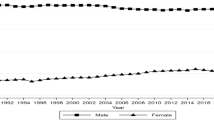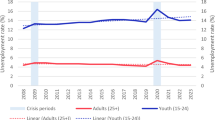Abstract
This paper looks at the evolution of the labour markets in Estonia, Latvia, and Lithuania since the beginning of transition until 2003, with a particular focus on labour force participation. How did labour supply in the Baltic countries respond to changes in minimum wages, unemployment benefits and retirement regulation? Do the marked differences in labour market policies between the countries result in different patterns of participation? What are the obstacles to and driving forces of participation? We find that relative contribution of participation and demographic trends to the dynamics of the labour force varied substantially both over the years and across the three countries. Participation, in turn, has been shaped by sometimes complicated interactions between schooling decisions of the youth, retirement, policy changes, and external shocks. Resulting differences in trends and patterns are quite substantial, indicating that there is a room for increasing participation in each of the countries. Panel data analysis of determinants of participation and discouragement based on labour force survey data suggests that increasing after-tax real minimum wage has significant positive effects on participation and reduces discouragement in Lithuania. In Estonia, by contrast, a positive effect of minimum wage on participation is found only for teenagers of both genders and for young males. We do not find any evidence that partner’s wage has a negative effect on participation. Ethnic minorities, especially females, in all three Baltic countries are less likely to be in the labour force, other things equal.





Similar content being viewed by others
Notes
In Estonia (until 2002) and in Lithuania UB were not taxed, so the ratio of UB to average net wage is used. For Latvia, where UB are taxed, Fig. 2 shows average UB—average gross wage ratio (the ratio of after-tax UB to net wage would be almost identical).
Here the term “discouraged worker” is used loosely, referring only to the reported reason for not seeking a job. According to the standard definition, only those inactive persons, who would like to work and are available for work, are categorised as discouraged. See further sections for a more detailed discussion of discouraged worker effect in the Baltic countries.
See Prescott (2004) for recent evidence on high elasticity of labour supply in G7 countries.
In Estonia we use 15 counties, but the capital city (400 thousand population) is separated from the rest of respective county; excluding capital city, average population of these units is about 90 thousand. In Lithuania we use fixed effects for 10 counties and three large cities, but local wages and (registered) unemployment are measured at municipality level; there are 60 municipalities with average population 59 thousand.
The endogeneity of the dummy for being a student/pupil is not addressed here.
Dummy for the 20–24 age group is interacted with deviation of parental income per core family member from its mean value, standartised by national average net wage. Using deviation ensures that interaction does not distort the main effect of the age group dummy.
More specifically, those who are not employed, have not been seeking for a job (or waiting for an earlier contracted job to start within 3 months) over the past 4 weeks, and answered “Yes” to the following two questions “Would you like to start working if there was an opportunity?” and “If you would have been offered a job last week, could you have started within two weeks?” (these are the Estonian LFS questions; Lithuanian ones are similar: “Even though you haven’t been looking for a job, would you like a job if a suitable one were available?” and “If you found a suitable job, could you start working within two weeks?”).
These models might suffer from sample selection. We have estimated probit with sample selection, but have found no evidence for error correlation between participation and discouragement equations; this, however, might be because the instruments were not too strong.
References
Boeri T (2001) Transition with labour supply. IZA Discussion Paper No. 257, Bonn
Boeri T, Terrel K (2002) Institutional determinants of labor reallocation in transition. J Econ Perspect 16(1):51–76
Boeri T, Burda M, Kollo J (1998) Mediating the transition: labour markets in Central and Eastern Europe. EPI Report No. 4, CEPR, London
Chase RS (2001) Labor market discrimination during post-communist transition: a monopsony approach to the status of Latvia’s Russian Minority. William Davidson Institute Working Papers Series, No. 381, http://eres.bus.umich.edu/docs/workpap-dav/wp381.pdf
Eamets R (2004) Labour market flows and adjustment to macroeconomic shocks in the Baltic States. Post-Communist Econ 16(1):47–71
Ehrenberg RG, Smith RS (2003) Modern labour economics, theory and public policy, 8th edn. Addison Wesley
Gronau R (1997) The theory of home production: the past ten years. J Labor Econ 15(2):197–205
Haltiwanger J, Vodopivec M (2002) Gross worker and job flows in a transition economy: an analysis of Estonia. Labour Econ 9(5):601–630
Hardin JW, Hilbe JM (2003) Generalized estimating equations. Chapman & Hall/CRC, Boca Raton, FL
Hazans M (2003a) Determinants of inter-regional migration in the Baltic countries. ZEI (Center for European Integration Studies, Univ. of Bonn) Working Paper No. B17-2003; http://ssrn.com/abstract=742184
Hazans M (2003b) Potential emigration of latvian labour force after joining the EU and its impact on Latvian labour market. BICEPS Working Paper, pp 1–56; http://ssrn.com/abstract=739305
Hazans M (2005) Unemployment and the earnings structure in Latvia. World Bank Policy Research Working Paper No. 3504, 90 pp; World Bank, Washington DC; http://ssrn.com/abstract=659103
Hazans M, Earle J, Eamets R (2002) Labour markets in the Baltic States. Background Paper for OECD (2003a, 2003b), mimeo
Hazans M, Rastrigina O, Trapeznikova I (2005) Family background and schooling outcomes before and during the transition: evidence from the Baltic countries. BICEPS Working Paper; http://ssrn.com/abstract=699443 (Revise and resubmit to J Popul Econ)
Heleniak T (2004) Migration in the Europe and Central Asia Region. Mimeo, Innocenti Research Centre, UNICEF (presented at World Bank policy seminar on migration, April 2004)
Hinnosaar M, Room T (2003) Labour market impact of the minimum wage in Estonia: an empirical analysis. In: Hinnosaar M, Rõõm T (eds) Labour market reseach in Estonia. Papers of the Research Seminar. Talinn, May 9, 2003. Eesti Pank, Tallinn, pp 61–92
Huber P, Brucker H, Kollo J, Traistaru I, Mickiewicz T (2002) Regional and labour market developments in canidate countries: a literature survey. ACCESSLAB Project Paper, WIFO (available at http://accesslab.wifo.ac.at/)
Jouhette S, Romans F (2005) EU force survey principal results 2004. EuroStat, Statistics in Focus, Population and Social Conditions, 9/2005
Kertesi G, Kollo J (2003) Fighting low equilibria by doubling the minimum wage? Hungary’s experiment. IZA Discussion Paper 970
Kollo J (2001) The patterns of non-employment in Hungary’s least developed regions. Budapest Working Papers on the Labour Market 2001/1, Hungarian Academy of Science, Institute of Economics, Budapest
Kroncke C, Smith K (1999) The wage effect of ethnicity in Estonia. Econ Transit 7(1):179–199
Liang K-Y, Zeger SL (1986) Longitudinal data analysis using generalised linear models. Biometrica 73:13–22
OECD (2003a) Labour market and social policies in the Baltic countries
OECD (2003b) Labour force dynamics in Estonia, Latvia and Lithuania, http://www.oecd.org/dataoecd/18/9/2493421.pdf
Prescott EC (2004) Why do Americans work so much more than Europeans? Fed Reserve Bank Minneapolis Quart Rev 28(1):2–13
Rutkowski J (2003) Rapid labor reallocation with a stagnant unemployment pool: the puzzle of the labor market in Lithuania. World Bank Policy Research Working Paper 2946
Saget C (1999) The determinants of female labour supply in Hungary. Econ Transit 7(3):575–593
StataCorp LP (2005) Stata longitudinal/panel data. Reference manual. Release 9. College Station TX
Storm V, Terrel K (2000) Sectoral restructuring and labor mobility: a comparative look at the Czech Reopublic. IZA Discussion Paper No. 111, IZA, Bonn
Svejnar J (1999) Labour market in the transitional Central and East European Economies. In: Ashenfelter O, Card D (eds) Handbook of labour economics, vol 3. Elsevier Science, pp 2810–2857
Traser J (2005) Report on the free movement of workers in EU-25. Who’s afraid of EU enlargement? European Citizen Action Service, Belgium
Vork A, Habicht J (2001) Disability benefits in Estonia – for the disabled or the unemployed? Paper Presented at 1st Nordic Econometric Meeting. Sandberg, May 24–27, 2001
Acknowledgements
Financial support from WIFO in the framework of the 5th Framework project “Regional Labour Market Adjustment in the Accession Candidate Countries” is gratefully acknowledged. I thank Raul Eamets for help with Estonian data, Peter Huber, Tiiu Paas, Dan Rickman, and two anonymous referees for useful comments.
Author information
Authors and Affiliations
Corresponding author
Appendix
Appendix
Rights and permissions
About this article
Cite this article
Hazans, M. Looking for the workforce: the elderly, discouraged workers, minorities, and students in the Baltic labour markets. Empirica 34, 319–349 (2007). https://doi.org/10.1007/s10663-006-9029-5
Published:
Issue Date:
DOI: https://doi.org/10.1007/s10663-006-9029-5




